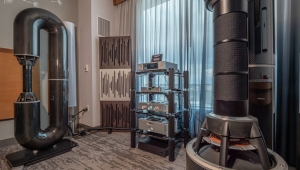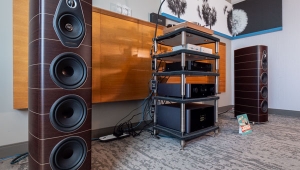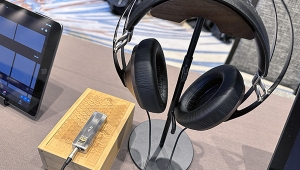| Columns Retired Columns & Blogs |
Accuphase DP-75V CD player Page 3
Two items of note:
First, the DP-75V took a full two weeks to warm up and pull its act together. If anything, it was too polite, warm, and over-the-top bloomy when I first lit it up. The '75 requires a long warm-up period. But wait...just wait for it.
First, the DP-75V took a full two weeks to warm up and pull its act together. If anything, it was too polite, warm, and over-the-top bloomy when I first lit it up. The '75 requires a long warm-up period. But wait...just wait for it.
Second, as with most components, its sound can be adjusted by running single-ended or balanced outputs, even using the same family of cable. I wired up both and enjoyed the ultimate luxury of switching between them with just a tap of the ML No.32's remote. I just as easily compensated for the '75V's inverted polarity on XLR. (The '75 adheres to the nonstandard Japanese standard of pin 3 hot, not pin 2.) But strangely---utterly oddly---this high-technology upsampler doesn't implement a polarity-inversion switch! All Accuphase preamps do, but so should the DP-75V, in my view, for ease of integration into "foreign" systems.
The difference in tonal balance between single-ended and balanced operation was quite noticeable---no one planted in the Ribbon Chair had trouble hearing it. As has been my experience, balanced XLR output was an order of magnitude quieter than single-ended, perhaps due to balanced running's common-mode rejection of noise. The XLR output more easily generated that big, floaty-free soundstage that audiophiles crave. Imaging was also a touch more round and full, as was the harmonic palette from top to bottom. The bass went just as deep as the single-ended outputs, but was a touch fatter and bigger, and sometimes more impressive than the tauter, faster bottom end of single-ended output, if with slightly less slam and speed. The midrange, too, was more lush and organic, the highs sweeter and perhaps a touch less extended when running in balanced mode.
Single-ended output retaliated with a faster, cleaner, more transparent soundstage with notably more color, snap, and vivid leading-edge energy. Imaging was also a tad more sharp and focused than in balanced mode. While I was able to hear more deeply into the soundstage, the single-ended sonic construct was slightly less airy---another effect I've come to expect. The sound could be further refined by carefully swapping cables for just the right overall balance. On some over-EQ'd pop recordings and a few multi-miked classical horrors, the XLR outputs proved a welcome and soothing balm. With well-recorded music, I almost always preferred single-ended's more colorful, driving presentation. Switching to single-ended from balanced, the frequency-response hinge, if you will, tilted up a bit, illuminating and quickening the pulse in the upper midrange and treble.
In either mode, the 24/192 upsamplers brought an enormous amount of perceived detail to bear on the music. For me, that upsampling pays dividends at the top and bottom, but with the '75, I latched onto it in the lushly textured midrange. I found a special sense of physicality to the sound. Detail was rendered so finely that everything sounded velvety, attractive, smooth, and human---which is perhaps what most audiophiles are reaching for. That sense of musical supercontact seemed to lift me right out of the Ribbon Chair.
It's all her fault---the luminous Alicia de Larrocha, that is, on Mostly Mozart (London 417 372-2), a mid/late-'80s German recording. (The inside front cover shows a portrait, from 1977, of a rather randy-looking Mozart as a Knight of the Golden Spur.) I was instantly charmed by Ms. de Larrocha's loving keyboard style, and Mozart's brooding Fantasy in c, K.475, has always held great significance for me. My dad would seat himself at the family Steinway "trying to play it" (his only modesty) before going out for the evening with my mother. So in some rote way (humming it?), in some spiritual way (the memories, save me!), I know this particular piece oh so terribly well. The DP-75V, matched with suitably reference-quality front-end components between its analog outputs and the speakers, just nailed it. I sat unmoving, unblinking, transported almost physically somewhere else until movement's end. (Freudians, please leave your notebooks at the door.)
The leading edge of the signal was quick and natural, so defining of space and time---a big piano in a reverberant space right here, right now, with a lot of body, and very ambient. The aural clues, the burst of light and decay of each note, were gorgeously rendered. Liquidity, extension, linearity, and effortless tonal color naturally extended from the soundstage. A powerful and balanced bottom end supported de Larrocha's heroic phrasing, the pace and timing in hand to perfectly render the elegant, restrained tonal elements. I was...awed.
But then I felt like indulging in a little Horowitz, and turned to the second movement of Beethoven's "Appassionata" Sonata, Op.57 (BMG 60375-2-RG). On this recording the analog tape hiss is fairly low in level, but there's some kind of wild roaring in the background---air-conditioning, perhaps? The recording sounded "nicely wet and ambient," according to my notes, "very bloomy, with less direct sense of the instrument than on the London de Larrocha." Horowitz keeps his embellishments to a minimum, thankfully, and renders this excruciatingly beautiful work with perfect timing; his pauses, restraint, and expressiveness are captivating. When the original theme doubles back on itself about two and a half minutes in, I thought it godlike. Five minutes and 27 seconds later, I remembered to breathe.
- Log in or register to post comments



































